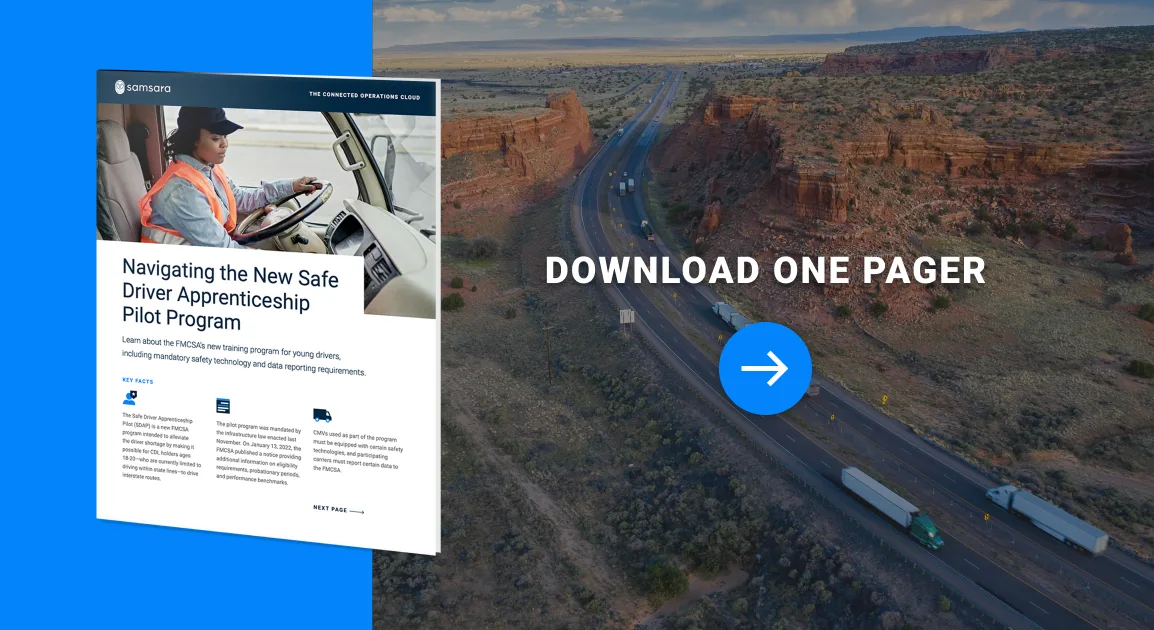Safety
Understanding the Safe Driver Apprenticeship Pilot (SDAP): New FMCSA Program to Train Young Drivers
January 25, 2022

By Caitlyn Chacon and Meera Bhaskar
Last updated on July 19, 2022: On July 11, 2022, the FMCSA announced that it will require both forward-facing and inward-facing video systems (i.e. dual-facing dash cams) to participate in the SDAP program.
In November, the Infrastructure Investment and Jobs Act (IIJA) was passed by Congress and signed into law by the president. Among many provisions, the $1.2 trillion infrastructure law provides $110 billion for roads, highways, bridges, electric vehicle infrastructure, and more that will impact the trucking industry.
While many of the provisions in the IIJA will take years to implement, one that is taking shape now is the Safe Driver Apprenticeship Pilot (SDAP). Based on the apprenticeship program originally outlined in the DRIVE Safe Act, the SDAP creates a pathway for younger drivers, ages 18 to 20, to participate in interstate commerce.
Intended to help address the national driver shortage, the SDAP is particularly relevant for motor carriers that cross state lines and are facing a shortage of truck drivers. In this article, we’ll break down what motor carriers need to know about the apprenticeship pilot program and <a href="#requirements" style="border-bottom: 1px solid #0384fb;">requirements for participating</a>.
What is the purpose of a young driver apprenticeship program?
According to estimates from the American Trucking Associations (ATA), the United States is facing a shortage of more than 80,000 truck drivers—a gap that may grow to 160,000 by 2030. As more than 70% of the nation’s freight is transported by commercial trucks, the driver shortage is exacerbating supply chain disruptions and causing concern across the trucking industry. This has led some industry groups, including the International Foodservice Distributors Association (IFDA), to call for legislative action.
To address this issue, a bipartisan group of lawmakers in both the House and Senate first introduced the Developing Responsible Individuals for a Vibrant Economy (DRIVE) Safe Act in 2021. The DRIVE Safe Act aimed to alleviate the trucking industry’s ongoing driver shortage by making it possible for commercial driver’s license (CDL) holders ages 18 to 20 to operate interstate routes after completing a rigorous apprenticeship program. Currently, CDL holders ages 18 or older are permitted to drive commercial motor vehicles (CMVs) within state lines everywhere in the country except Hawaii. The DRIVE Safe Act would override a federal law in place since 1938—before the creation of the interstate highway system—that bans CDL holders under the age of 21 from driving a CMV across state lines.
Proponents of the Drive SAFE Act, including the ATA, have praised the apprenticeship program as a “common sense” way to help address the national driver shortage by increasing the pool of eligible drivers for interstate trucking. Critics of the legislation have raised concerns about safety, noting that younger CMV drivers have higher crash rates, and voiced concerns that the training program may not adequately address the driver shortage, which they attribute to problems around driver retention.
What was passed as part of the new infrastructure law?
A pilot of the apprenticeship program was mandated by the infrastructure law signed on November 15, 2021. The legislative text instructs the Secretary of Transportation to start the pilot program within 60 days and outlines certain requirements, including a requirement that CMVs used as part of the program must be equipped with <a href="#safety-technology-requirements" style="border-bottom: 1px solid #0384fb;">certain safety technologies</a> (including an active braking collision mitigation system and a forward-facing dash cam). Update: On July 11, 2022, the FMCSA announced that it will require both forward-facing and inward-facing video systems (i.e. dual-facing dash cams) to participate in the SDAP program.
On January 13, 2022, the Department of Transportation (DOT) released a bulletin announcing next steps on several trucking-related federal initiatives—including the apprenticeship program pilot, which they officially coined the Safe Driver Apprenticeship Pilot (SDAP). The DOT bulletin announced that the Federal Motor Carrier Safety Administration (FMCSA) would be screening motor carriers to determine their eligibility to participate in the SDAP according to strict safety standards. It also said the FMCSA would “conduct outreach to motor carriers with excellent safety records inviting their participation in the program.”
<div id="requirements">What is required for motor carriers and drivers to participate in the pilot program?</div>
The same day that the DOT officially announced the Safe Driver Apprenticeship Pilot (SDAP)—January 13, 2022—the FMCSA published a Federal Register notice providing additional information about how the pilot program will work, including eligibility requirements and training program details. In the coming days, we expect the FMCSA may release additional guidance. Here is what we know so far:
Driver eligibility
The pilot program is open to 18- to 20-year-old drivers who already hold a commercial driver’s license (CDL) in their state.
To qualify for participation, CDL holders must meet certain standards outlined here in the Federal Register notice.
If an apprentice has a major offense, serious traffic violation, railroad-highway grade crossing violation, or violation of an out-of-service order during the pilot program, he or she will be disqualified and removed from the program.
No more than 3,000 apprentices can participate in the pilot program at any given time.
Motor carrier eligibility
Motor carriers that would like to participate in the pilot program must complete an application for participation. The FMCSA is not accepting applications yet, but the agency said they would publish an announcement on their website once applications are being accepted.
To qualify for participation, motor carriers must meet certain standards, including a satisfactory safety rating and no open enforcement actions in the previous six years. See the full list of motor carrier eligibility criteria here.
Probationary periods & performance benchmarks
The apprenticeship program pilot consists of two safety training probationary periods: a 120-hour probationary period and a 280-hour probationary period.
During both probationary periods, an apprentice may transport goods across state lines but must be accompanied by an experienced driver in the passenger seat. The FMCSA defines an experienced driver as “one at least 26 years old who has held a CDL, been employed for at least the past two years, has at least five years of interstate CMV experience, and has had no preventable accidents reportable to the agency or pointed moving violations.”
The first probationary period must include at least 120 hours of on-duty time, of which at least 80 hours are driving time in a CMV. During this period, the employing motor carrier must ensure the apprentice completes the required hours of driving time and is competent in each of the following areas:
Interstate
City traffic
Rural 2-lane and evening driving
Safety awareness
Speed and space management
Lane control
Mirror scanning
Right and left turns
Logging and complying with rules relating to hours of service
After the 120-hour probationary period is complete, the apprentice must then complete the second probationary period. During the second probationary period, the apprentice must complete 280 hours of on-duty time, including no fewer than 160 hours of driving time in a CMV. During this period, the employing motor carrier must ensure the apprentice completes the required driving time and is competent in each of the following areas:
Backing and maneuvering in close quarters
Pre-trip inspections
Fueling procedures
Weighing loads
Weight distribution and sliding tandems
Coupling and uncoupling procedures
Trip planning, truck routes, map reading, navigation, and permits
Once an apprentice completes both probationary periods, they are then permitted to cross state lines without being accompanied by another driver. However, the FMCSA notes that the apprentice is “still considered to be participating in the Safe Driver Apprenticeship Pilot Program, and their safety performance must continue to be monitored by the employing motor carrier, including monthly safety performance reports filed with FMCSA, until the driver reaches the age of 21.”
<div id="safety-technology-requirements">CMV safety technology requirements</div>
All CMVs operated by apprentices as part of the pilot program must be equipped with specific vehicle safety technologies:
An automatic manual or automatic transmission.
An active braking collision mitigation system.
A forward-facing video event capture system. Update: On July 11, 2022, the FMCSA announced that it will require both forward-facing and inward-facing video systems (i.e. dual-facing dash cams) to participate in the SDAP program.
A governed speed of 65 miles per hour at the pedal and under adaptive cruise control.
The FMCSA specifies that “nothing in the notice prevents an employer from requiring or installing additional technologies in a CMV.”
Motor carrier reporting requirements
Participating motor carriers must submit monthly data on each apprentice’s activity (such as vehicle miles traveled, duty hours, driving hours, off-duty time, or breaks), safety outcomes (including crashes, violations, and safety-critical events), and any additional supporting information (such as data from onboard monitoring systems or investigative reports from previous crashes).
In addition, participating motor carriers will be required to notify the FMCSA within 24 hours of:
Any injury or fatal crash involving an apprentice.
An apprentice receiving an alcohol-related citation in any vehicle (such as driving under the influence or driving while intoxicated).
An apprentice choosing to leave the pilot program.
An apprentice leaving the carrier.
An apprentice failing a random or post-crash drug/alcohol test.
Stay ahead of the curve with Samsara
Samsara is here to help you navigate new public policies like this one. If you’re interested in participating in the Safe Driver Apprenticeship Pilot (SDAP), download the one pager below to learn how Samsara can help you meet the program’s technology requirements and train new drivers with confidence.
 Download one pager
Download one pager 















